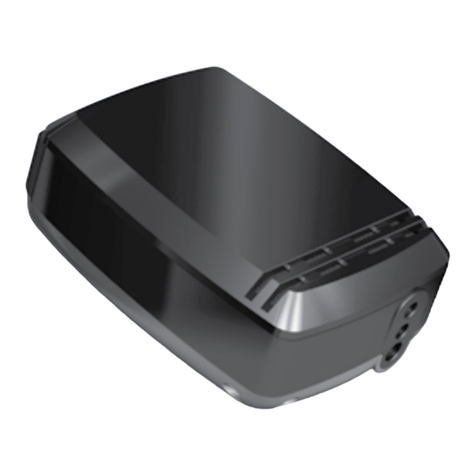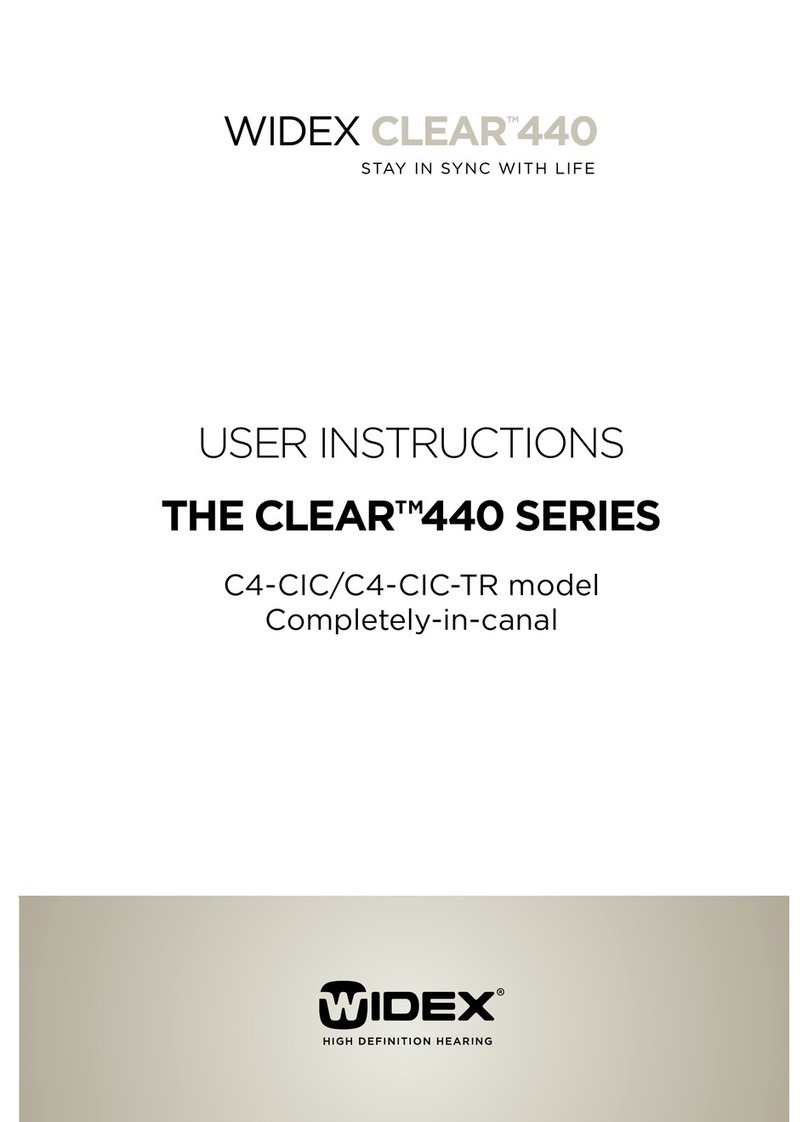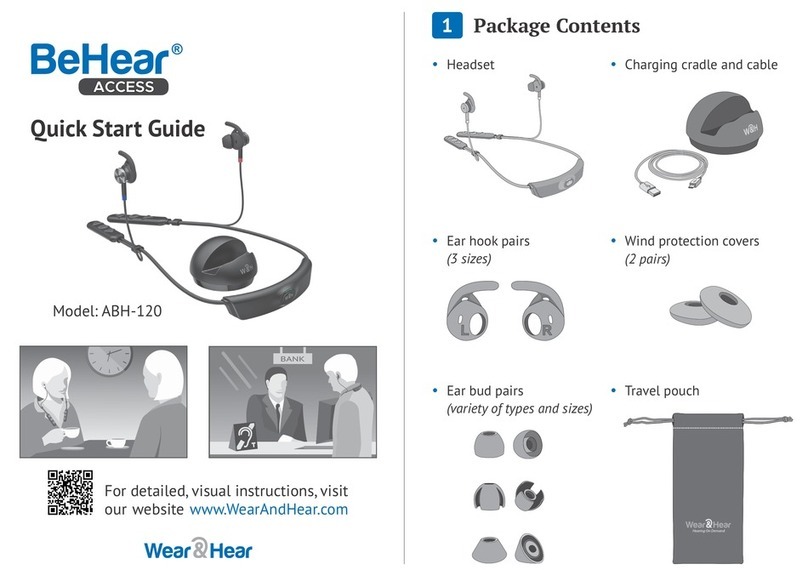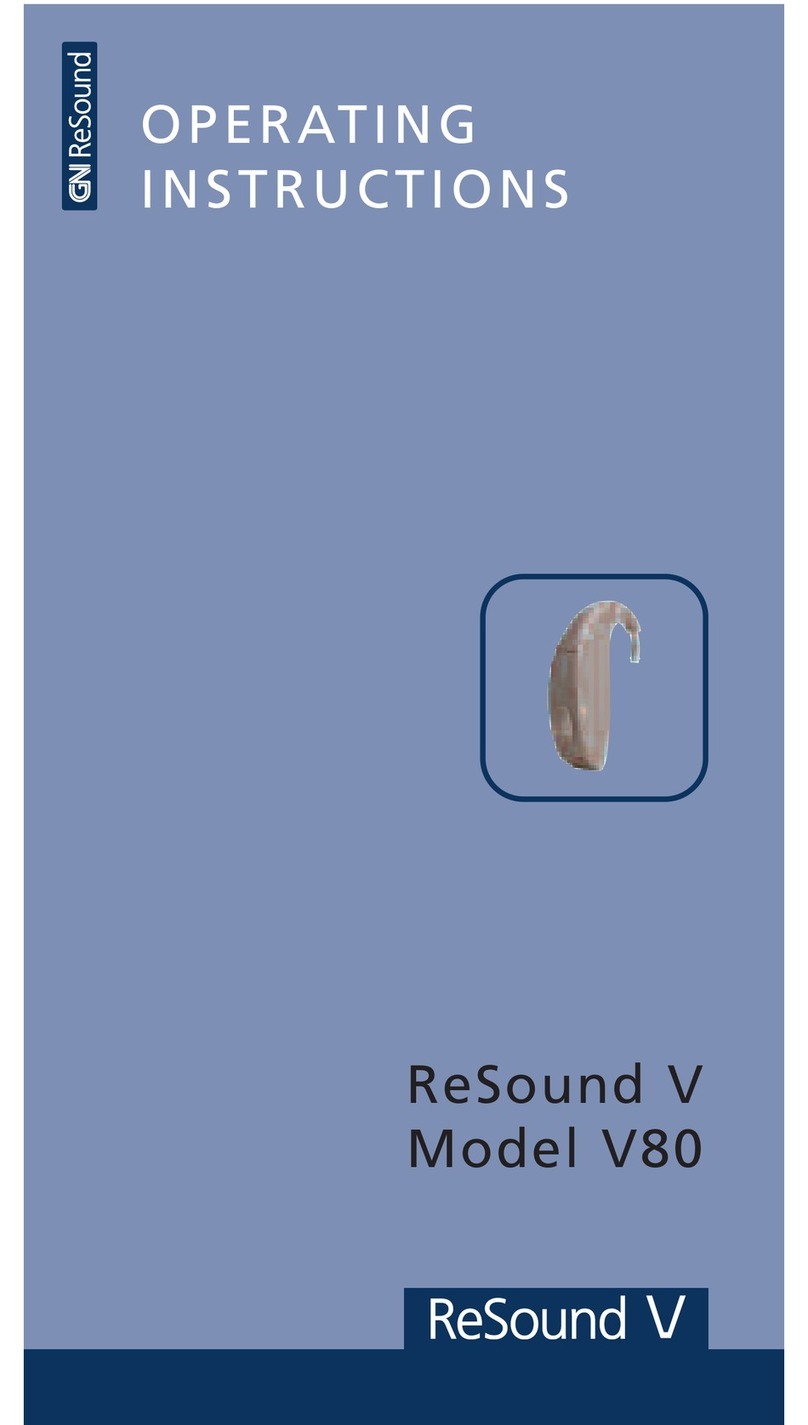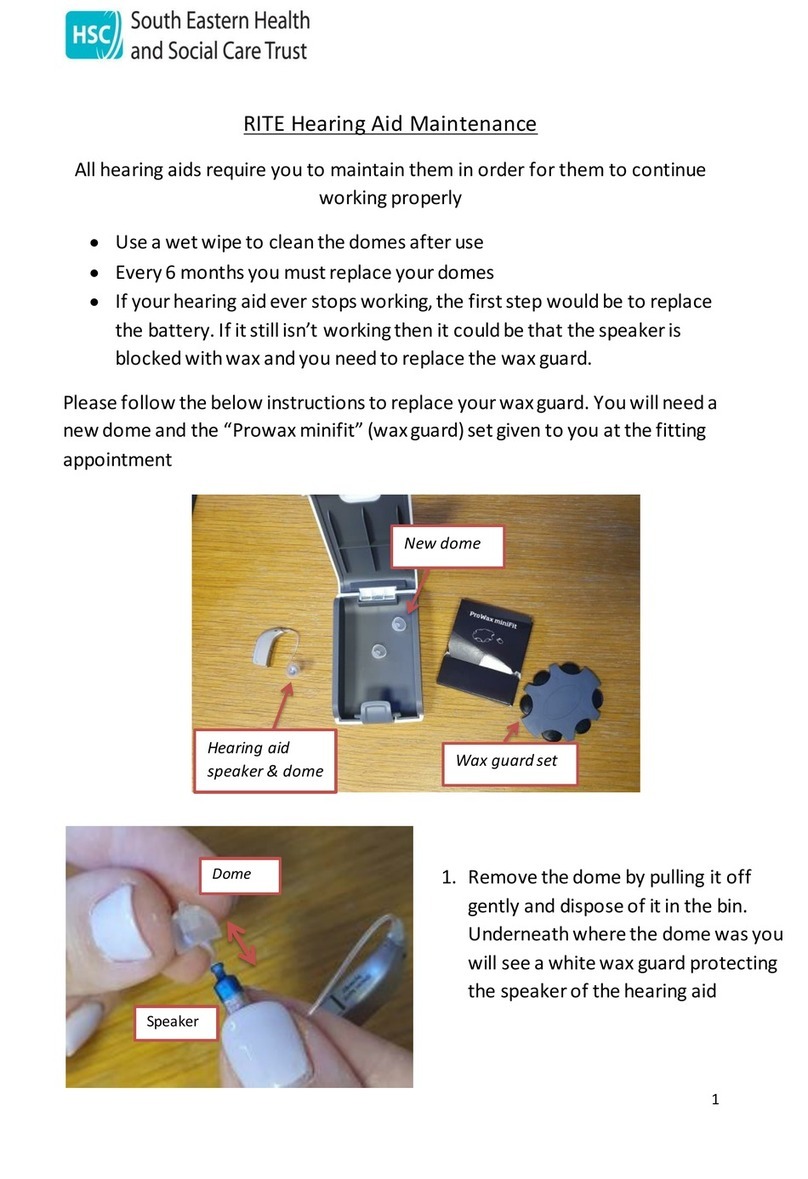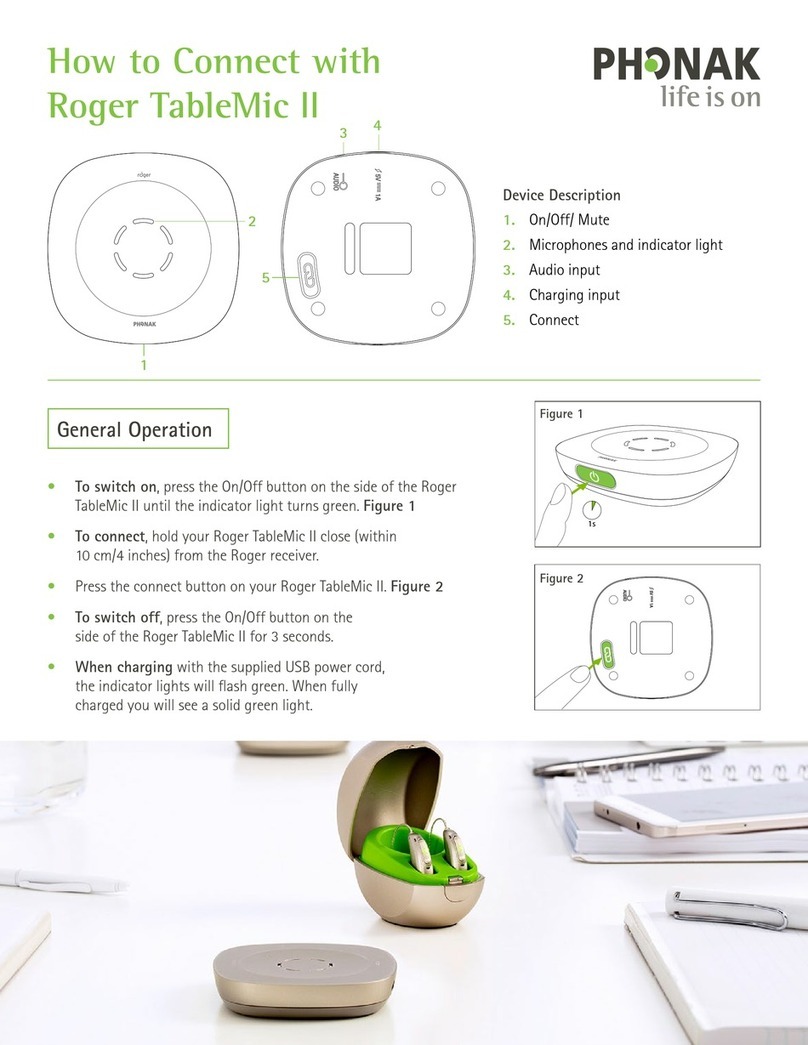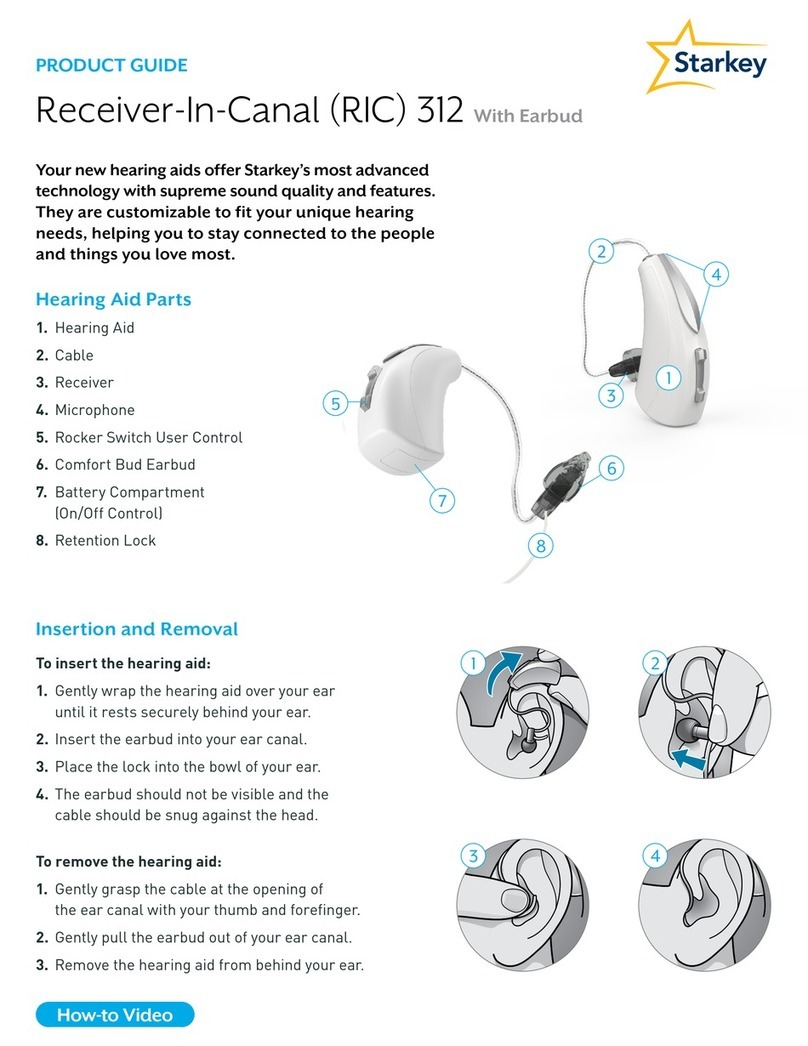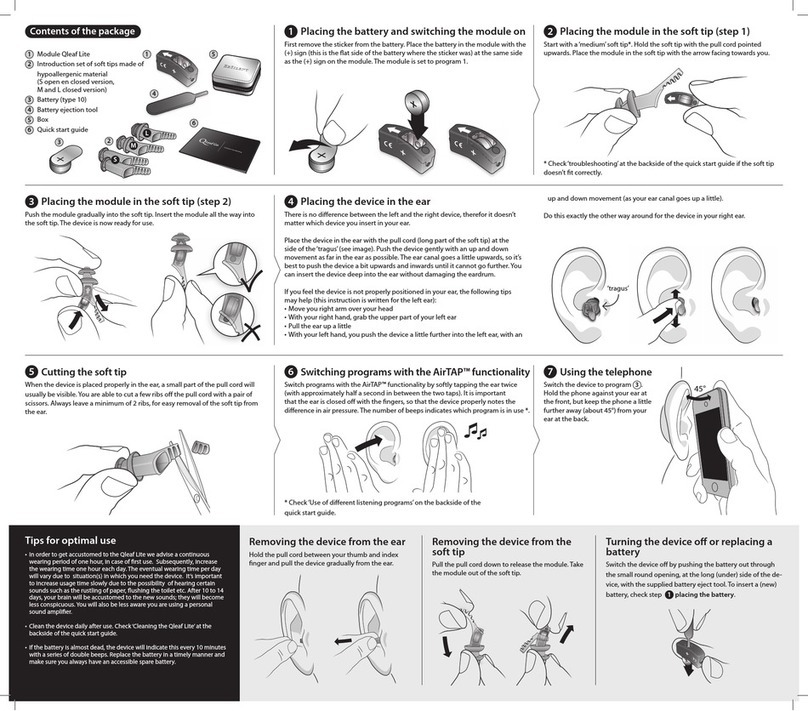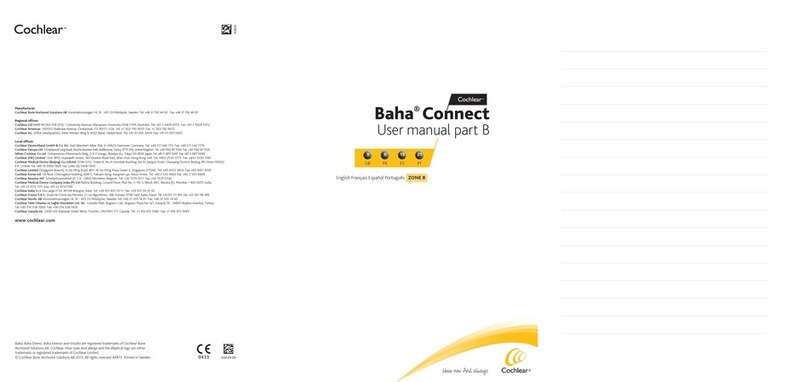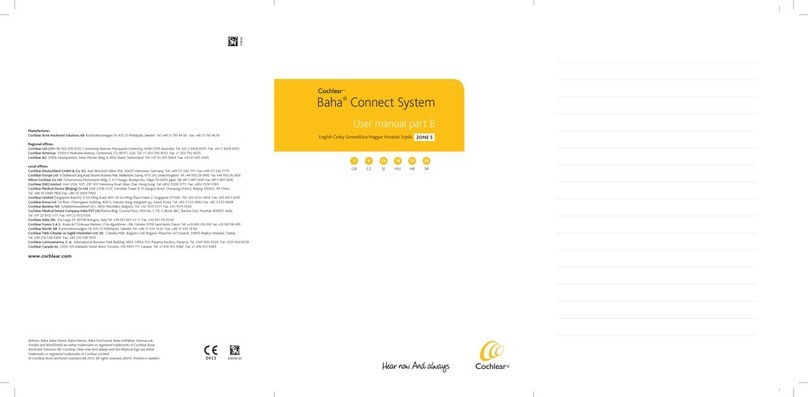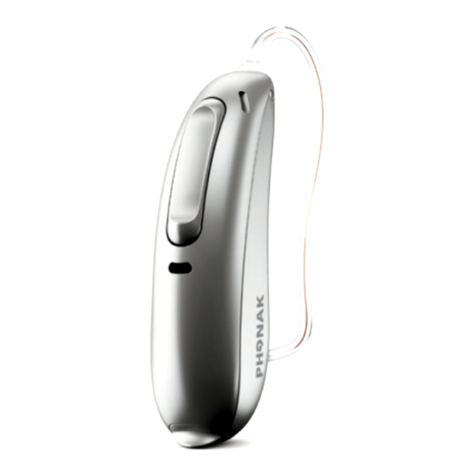Songbird Flexfit User manual

Digital Hearing Aid
User Instructional
Brochure
Flexfit
Flex
New &
Improved!
New &
Improved!

1
www.SongbirdHearing.com
Congratulations and welcome to Songbird.
This brochure provides you with easy-to-follow
instructions for using and maintaining your hearing
aid. It also contains important medical information
as well as information about what to expect when
you start to use the product. If you have any
further questions, do not hesitate to call us at
1-800-789-1830 or visit our website at
www.SongbirdHearing.com.
Important: Please read this entire guide before
using your new Songbird.
Your purchase of the Songbird Flexfit®Digital
Hearing Aid includes a protective case, your
hearing aid, two “312” hearing aid batteries,
optional foam rings, and a wax removal tool. An
insert with Technical Information is also included
for your reference.
The new and improved Songbird Flexfit was
designed to be the ultimate in performance and
convenience. Its innovative technology enables
you to get more life out of standard 312 batteries
than traditional digital aids. Also, its unique
modular design enables easy battery replacement
and flexible maintenance options, allowing you to
replace the Earpiece at your convenience.
Using Your Hearing Aid ................................ 2-11
Cleaning Your Hearing Aid .......................... 12-13
Songbird’s Unique Modular Design.............. 14 -16
Helpful Hints ................................................. 17
Medical Information and Warnings ..............18-20
How Do You Know If You Have Hearing Loss?
20-21
Adjusting to Wearing Hearing Aids...............22-23
Dos and Don’ts..........................................24-25
Troubleshooting.........................................26-29
Important Reminders ......................................30
Children with Hearing Loss .............................. 31
Important Notice for Prospective Users........32-33
100% Satisfaction Guarantee.....................34-35
Songbird Products & Accessories .....................35
Questions and Comments................................36
Table of Contents

2
3
www.SongbirdHearing.com
Using Your Hearing Aid
The Main Body is the
portion of the hearing
aid that houses most
of the electronics.
This piece connects
to the Earpiece and
includes the:
Volume Control. This makes the sound louder
or softer. This also serves as the “On/Off”
switch.
The Earpiece is
the portion of
the hearing aid
that includes the
battery holder,
the cord, and the
tip. This piece
connects to the
Main Body and
includes the:
Cord. It extends over your ear and is adjustable
to give you optimal fit and comfort.
Tip. Fits comfortably inside the ear to direct
the sound in. Slots in the tip allow sound to
pass through the aid into the ear.
Tip Handle. Handle helps to insert and remove
the tip.
Battery Holder. Use “312” hearing aid
batteries.
Volume
Control
Cord
Tip
Tip
Handle
Battery
Holder
Main
Body
Earpiece
Finger
Grips
Your new Songbird
has two main
components, the
Main Body and
the Earpiece. The
finger grips are
used to open the
hearing aid.

4
5
www.SongbirdHearing.com
Instructions For Use
1. Open the hearing aid case
Remove the outer packaging, then slide
open the case and remove the hearing aid.
2. Insert the Battery
Use the finger grips to open the hearing aid.
This will expose the battery holder.
Using Your Hearing Aid (continued)
Remove the visible tab on the 312
battery and gently place the battery
into the holder in the lower portion of
the hearing aid. You will know that the
hearing aid is facing the right way when
the open bowl of the battery holder is
facing you. Insert the battery with the
plus sign “+” facing you. Gently close
the two portions of the hearing aid. The
hearing aid will not close if the battery is
inserted the wrong way.
Note: If the Main Body and the Earpiece
come apart, see page 15 for how to
put them back together.
Insert
battery
with plus
sign facing
you

6
7
www.SongbirdHearing.com
3. Turn on and set volume level
Turn the hearing aid on to the desired
volume by rotating the volume control
from the red line (Off) to
1, 2, or 3. The higher the
number, the louder the
hearing aid will be.
Tip: If you are trying this
for the first time,
it is recommended
that you start on the
mid-range volume
setting, 2, then
adjust as needed.
Using Your Hearing Aid (continued)
ONONON
7
4. Put the body behind your ear,
then insert the tip
Place the body behind your ear, with the
cord hanging in front of your ear (A). Grasp
the tip handle and slowly push and wiggle
the tip into your ear as far as it will go (B).
AB
A
B

8
9
www.SongbirdHearing.com
5. Put the body behind your ear,
then insert the tip
(continued)
For the most secure fit, pull up and back on
your ear as shown while pushing the tip into
place (A). The tip handle is intended to keep
the tip from going too far and should still be
visible when looking into the ear (B).
Using Your Hearing Aid (continued)
Tip: If you hear a whistling sound (feedback),
use your finger to reposition the tip. If
it persists, lowering the volume or using
the enclosed optional foam rings can
help eliminate the whistling.
AB
6. Adjust the cord length (if needed)
If the cord is too short to
insert the tip or too long
and not snug over the ear,
take the hearing aid off
(see Remove below) and
pull the cord through the
hearing aid body to adjust.
7. Remove
While the tip is in your ear, grasp the body
and gently take it off your ear. Then, grasp
the cord as close to the tip as possible and
gently wiggle the tip out of your ear.
IMPORTANT: Do not use the body to pull the
tip directly out of the ear. This may strain the
cord and could damage the earpiece.
Shorten
Lengthen

10
11
www.SongbirdHearing.com
8. Turning off
To turn the Songbird off
and conserve battery life,
rotate the volume control
down so that the red line
is completely visible. As
you do this, you may feel
a slight “click.” Turn the
control as far as it will go.
IMPORTANT: If the red line is not completely
visible at the top of the hearing aid wheel,
then the hearing aid is not turned off.
Using Your Hearing Aid (continued)
OFFOFF
Red
Line
Yo u will
feel a
slight click
9. Replacing batteries
To replace the battery, simply open the
hearing aid and remove the battery. Refer
to pages 4 & 5 to ensure you are inserting
the battery correctly. Once the fresh battery
is inserted, close the two portions, turn the
Volume Control ON, and the hearing aid will
power up. If the two pieces come apart, see
page 15 for how to put them back together.
IMPORTANT: Make sure the circular bullseye
design on the side of the hearing aid is
facing you. This will ensure the battery does
not fall out when you open the hearing aid.
10. Storing
Store your Songbird in the protective case
when it is not in use.
Hold
with
circular
design
facing
you

12
13
www.SongbirdHearing.com
Cleaning Your Hearing Aid
(and Your Ears)
Periodically wipe the entire tip of the•
hearing aid with a dry tissue or slightly
moist (not wet) cloth.
Occasionally, wax and debris may accumu-•
late in the tip of the hearing aid. To remove
this wax, use the enclosed wax removal tool
to gently scoop away anything you might
see inside the tip after each use. You will
see the wire loop go underneath the rubber
tip – scrape out the wax, but do not push
the wire loop all the way down.
If wax accumulation causes the hearing aid•
to fail and cleaning does not resolve the
issue, the Earpiece can be easily replaced
(see page 16).
It is important to keep your ears clean to•
maximize the life of your Songbird. Earwax
can clog up your hearing aid and cause it
to not work properly. For best results, it
may be beneficial to clean your ears with
commercially available ear wash systems
or visit your doctor for treatment.
Never• use instruments like cotton swabs,
toothpicks, hairpins, or the enclosed wax
removal tool to remove wax from the
ear canal.
If you have excessive earwax you should
discontinue using the hearing aid and
consult your physician.

14
15
www.SongbirdHearing.com
When the two portions come apart, you can
attach them by:
1. Holding the Main Body part of the hearing
aid in your left hand with the circular design
facing you.
2. Attaching the hooks on the Earpiece (A) to
the pins on the Main Body (B). This will create
the hinge.
IMPORTANT: Do not attempt to close the
hearing aid if the hooks are not attached to
the pins, as this can cause permanent damage
to the body.
Your Songbird was designed to open into two
pieces. The Main Body houses the Volume
Control and other electronics and should
not be thrown away. The earpiece portion is
replaceable.
The two portions open to allow easy
replacement of the 312 battery. The
two portions also come apart to enable
replacement of the Earpiece.
Songbird’s Unique
Modular Design
BA
B
A

16
17
www.SongbirdHearing.com
Replacing the Earpiece
Wax build-up in the hearing aid is typically
the #1 cause of failure for traditional hearing
aids, often resulting in costly repairs and/
or a need for total hearing aid replacement.
For your convenience, the Songbird has been
designed to allow you to easily replace the
Earpiece without the hassle or high expense
of full hearing aid replacement or repairs.
If after ongoing use you find that inserting
new batteries and cleaning the tip do not
restore normal volume levels, then it may
mean that you need to replace the Earpiece.
IMPORTANT: To extend the life of your aid,
make sure to clean the tip as directed.
You can order replacement Earpieces at
www.SongbirdHearing.com or by calling
Customer Service at 1-800-789-1830.
Songbird’s Unique
Modular Design (continued) Helpful Hints
Now that you know how to use your Songbird,
here are some things to keep in mind as you
adjust to your new hearing experience.
It takes time to get used to new sounds –•
the brain needs time to adjust. Be patient
and keep at it – wearing your Songbird
regularly will help you adjust.
You may also notice lots of background•
noises. These have almost always been a
part of your environment, and in time you
will tune out many of them.
It also may take time for a hearing aid to•
feel comfortable – try wearing it for short
periods of time, then gradually increase and
it will soon feel more natural.
The rest of this booklet contains more helpful
information about getting the most out of
your Songbird experience. We encourage you
to refer back to it from time to time.

18
19
www.SongbirdHearing.com
Use
For safe, comfortable amplification for mild
to moderate hearing loss in healthy adults 18
years of age and older.
Not For Use In Children. This product is not
for use by anyone under 18 years of age.
Warnings
Hearing loss can be the symptom of a more
serious medical condition or the result of
an excessive wax build-up. A physician
can treat these conditions. If you have
not already done so you should consult
a licensed physician (preferably one who
specializes in diseases of the ear) to rule out
any of these medical concerns. Physicians
who specialize in diseases of the ear are
often referred to as ENTs, otolaryngologists,
otologists, or otorhinolaryngologists.
Medical Information
and Warnings
Consult your doctor before use if you have
or think you may have:
History of excessive wax build-up•
Pain or discomfort in the ear•
Fluid or drainage from the ear within the•
past 90 days
Ear canal blockage, a lasting ear infection•
or a plugged up fullness feeling
Visible deformity of the ear•
Sudden, rapidly progressing, or fluctuating•
hearing loss within the past 90 days
Ringing in only one ear•
Hearing loss only in one ear that worsened•
in the past 90 days
Spells of acute or chronic dizziness•
Stop use and ask a doctor if:
Hearing in one or both ears worsens•
Hearing does not improve during use•
You experience skin irritation or ear pain•

20
21
www.SongbirdHearing.com
Hearing Aid Ingestion Warning:
Keep out of reach of children and pets. Do
not swallow. May pose a choking or ingestion
hazard. Contains small parts and a battery.
In the US, in the event a hearing aid is
swallowed, call collect: The National Button
Battery Ingestion Hotline (202) 625-3333
for counsel or treatment.
How Do You Know If You Have
Hearing Loss?
Hearing loss can be due to aging, exposure
to loud noise, medications, infections, head
or ear trauma, congenital or hereditary
factors, and other illnesses and causes.
This is why it is always important to first
have a medical examination with your doctor
prior to using a hearing aid to rule out any
medical conditions. The vast majority of
hearing problems do not require medical or
surgical intervention, and can be corrected
with hearing aids.
Medical Information
and Warnings (continued)
You may have a hearing loss if…
You frequently complain that people mumble,•
speech is not clear, or you hear only parts
of conversations when people are talking.
You often strain to hear or ask people to•
repeat what they said.
Your friends or relatives tell you that you•
don’t seem to hear very well.
Others say that you play the TV or radio too•
loudly.
You do not laugh at jokes because you miss•
too much of the story.
You need to ask others about the details of•
a meeting that you just attended.
You cannot hear the doorbell or the tele-•
phone.
You find that looking at people when they•
talk to you makes it somewhat easier to
understand.
Please visit our website at
www.SongbirdHearing.com for additional
information on hearing loss.

22
23
www.SongbirdHearing.com
A hearing aid is only an aid to hearing; it is
impossible to restore hearing to normal. It
takes time to get used to hearing aids and
gain their full benefits.
It takes time to get used to hearing aids•
and having something in your ear. The brain
has to adjust to the new sounds; some
people adjust very quickly, others may take
up to 2-3 months.
Initially you may notice a lot of background•
sounds. Keep in mind that background
noise is almost always part of your
environment, and adjustment to it is
required. In time, you will tune out many
of these everyday sounds. Studies suggest
that your ability to understand speech may
continue to increase over a period of several
months when wearing a new hearing aid.
You may start out feeling like everything is•
too loud or noisy; try starting out with the
hearing aid set to a lower volume setting to
give yourself time to adjust.
Adjusting to Wearing
Hearing Aids
You may also feel plugged up or feel like•
you’re talking in a barrel. This is a normal
reaction to wearing new hearing aids, and
the sensation will usually go away in the
first few weeks. With patience and time,
you should get lots of benefit from your
hearing aids.
Be patient. Some people adjust very quickly,•
most adapt within a few weeks. Start out
wearing your hearing aid for short periods of
time and gradually increase. Wearing your
aids regularly will help you adjust to them.
Using the telephone
If your hearing aid whistles (feedback) while•
on the phone, tilt the telephone away from
your ear until the whistling stops.
Try various positions with the telephone•
until you discover the arrangement that
works best for you.

24
25
www.SongbirdHearing.com
Your hearing aid is a precision instrument.
To ensure the greatest performance and life
these precautions should be followed:
Dos
DO• periodically wipe the tip with a dry or
slightly moist (not wet) cloth.
DO• clean the tip by using the wax removal
tool to gently scoop away any visible wax
and debris.
DO• keep your hearing aid in the provided
case when it is not in your ear, as this will
keep the hearing aid dry and protected.
DO• turn your hearing aid off when not in
use; this will extend battery life.
DO• try to keep your hearing aid dry and free
of excess moisture.
Dos and Don’ts of Caring for
Your New Hearing Aid(s):
Don’ts
DON’T• allow any liquid to enter the
hearing aid.
DON’T• wear while swimming or
bathing.
DON’T• drop, throw, or handle roughly.
DON’T• apply hair spray while wearing your
hearing aid.
DON’T• leave your hearing aid where small
children or pets can get it.
DON’T• expose your hearing aid to
excessive temperatures such as heat
lamps, hair dryers, stoves, windowsills, or
your car’s glove compartment.
DON’T• try to alter your hearing aid or
attempt to make repairs, as this will cause
serious damage and void your warranty.

26
27
www.SongbirdHearing.com
Troubleshooting
ProblemProblem CauseCause Possible CurePossible Cure
Aid not properly
inserted
Review the instructions
and attempt to reinsert.
Visit our website
www.SongbirdHearing.com
for additional information,
or call 1-800-789-1830.
Hearing aid
does not fit
Hearing aid
does not fit
Tip is too large to fit
into the ear
Cord is not adjusted
properly
Product may not fit you.
Consult your physician.
Aid not turned on Review the instructions, and
turn the aid on using the
volume control. Make sure
the battery is in correctly.
Adjust the cord length to make
it shorter or longer so that the
body fits comfortably behind,
and the tip inside the ear
Hearing aid
not working
Hearing aid
not working
Hearing aid got wet Open the hearing aid,
remove the battery, dry all
parts of the hearing aid with
a lint-free cloth, then allow
to air-dry completely.
Battery dead Replace battery
Battery low Replace battery
You have more
severe hearing loss
Wax blocking
tip Clear tip blockage; replace
Earpiece if blockage cannot
be cleared (see page 16)
Consult your physician
ProblemProblem CauseCause Possible CurePossible Cure
Aid not properly
inserted
Remove tip and reinsert.
Also consider using the
enclosed optional foam ring
Volume too loud Adjust the volume control
down to a lower setting
Wax partially
blocking tip
Clear tip blockage; replace
Earpiece if blockage cannot
be cleared (see page 16)
Cord pulling tip out
of ear (cord too short)
Remove hearing aid and
lengthen the cord
Tip slipped out of
ear canal
Push the tip back into
the ear canal
Wax in ear canal Clean ears
Whistles
(feedback)
Whistles
(feedback)
Hearing aid is
intermittent
Hearing aid is
intermittent
Battery low Replace battery. If that
does not work, replace
the bottom half
Tip not properly
inserted
Remove and reinsert
Need time to adjust
to hearing aid
Remove hearing aid and
give ear time to rest
Cord digging into
the ear (cord too
short)
Remove hearing aid and
lengthen the cord
Ear feels soreEar feels sore

28
29
www.SongbirdHearing.com
Troubleshooting (continued)
ProblemProblem CauseCause Possible CurePossible Cure
Tip keeps
slipping out
Tip keeps
slipping out
Tip moved out of
ear canal
Push the tip back into
the ear canal
Tip too large or small
to fit properly
Product may not fit you.
Other Songbird products
may fit you better.
Visit our website
www.SongbirdHearing.com
for additional information,
or call 1-800-789-1830.
If our other products do not
fit your needs, consult your
physician.
Feel plugged up
(occlusion)
Feel plugged up
(occlusion)
Need time to adjust
to hearing aid
Wear for short periods
to get used to sound
Voice sounds
funny (occlusion)
Voice sounds
funny (occlusion)
Need time to adjust
to hearing aid
Wear for short periods to
get used to sound
ProblemProblem CauseCause Possible CurePossible Cure
Hearing aid is
not loud enough
Hearing aid is
not loud enough
Wearing hearing aid
on lowest setting
Use the volume control to
increase the volume
Wax blocking
tip
Clear tip blockage; replace
Earpiece if blockage cannot
be cleared (see page 16)
You have more
severe hearing loss
Consult your physician
Hearing aid is
too loud
Hearing aid is
too loud
Wearing hearing aid
on highest setting
Use the volume control to
lower the volume
Battery not
inserted correctly
Battery not
inserted correctly
Hearing aid will
not close
Remove battery and reinsert
(pages 4 & 5 for more details)
Halves not closed
completely
Halves not closed
completely
Check halves are connected
properly (page 15 for details)
Need time to adjust
to hearing aid
Wear for short periods
to get used to sound
If your problem cannot be resolved with the table
above then please contact customer service at
1-800-789-1830 for further assistance.

30
31
www.SongbirdHearing.com
Important Reminders
Songbird’s Flexfit is designed for mild to•
moderate hearing loss. If you recognize
you may have a more severe hearing loss,
or feel it does not meet your hearing
needs, you should consult your physician
or hearing health professional for a full
evaluation of your hearing loss.
No hearing instrument can restore•
normal hearing or prevent or improve a
hearing impairment resulting from organic
conditions. You must be patient while
adjusting to your hearing aid.
In most cases, infrequent use of a hearing•
instrument does not permit a user to
attain full benefit from it.
The use of a hearing aid is only part of•
hearing rehabilitation and may need to
be supplemented by auditory training and
instruction in lip reading.
Children with Hearing Loss
Hearing loss may cause problems in the
language development and the educational
and social growth of children. A child with
a hearing loss should be evaluated by a
physician who specializes in care of the
ears and hearing (an otologist or pediatric
otolaryngologist, also called ENT – Ear,
Nose and Throat physician, ideally with
subspecialty interest in care of children
with hearing impairment). After a medical
evaluation the child with hearing impairment
should be directed to an audiologist for
further evaluation and rehabilitation.
Audiologists are qualified by training and
experience to assist in the evaluation and
rehabilitation of children with hearing loss.
Songbird Hearing Inc. recommends, and
certain state regulations require, that all
individuals younger than the age of 18 years
old undergo a medical evaluation within three
months prior to the dispensing of a hearing
aid.
This product is not intended for use by
anyone under the age of 18.

32
33
www.SongbirdHearing.com
Important Notice for
Prospective Users
Information for U.S. users from the
Federal Drug Administration, Department
of Health, Education, and Welfare, Rules
and Regulations for Medical Devices part
801-Hearing Aid Devices, Professional and
Patient Labeling and Conditions for Sale:
Good health practice requires that a
person with a hearing loss have a medical
evaluation by a licensed physician
(preferably a physician who specializes
in diseases of the ear) before purchasing
a hearing aid. Licensed physicians who
specialize in diseases of the ear are often
referred to as otolaryngologists, otologists,
or otorhinolaryngologists. The purpose of
medical evaluation is to assure that all
medically treatable conditions that may
affect hearing are identified and treated
before the hearing aid is purchased.
Following the medical evaluation, the
physician will give you a written statement
that your hearing loss has been medically
evaluated and you may be considered a
candidate for a hearing aid.
Federal law restricts the sale of hearing aids
to those individuals who have obtained a
medical evaluation from a licensed physician.
Federal law permits a fully informed adult to
sign a waiver statement declining the medical
evaluation for religious or personal beliefs
that preclude consultation with a physician.
The exercise of such a waiver is not in your
best health interest and its use is strongly
discouraged.
Discard hearing aids in accordance with all
applicable federal, state and local regulations.

34
35
www.SongbirdHearing.com
If for any reason during the first 30 days
after purchase you are dissatisfied with the
product, you may return it to the original
location of purchase and you will be provided
a full refund of the original purchase price,
less shipping and handling.
If you have purchased this product by phone
or the internet directly from Songbird, please
contact Songbird Customer Service at
1-800-789-1830 for return instructions.
Warranty
The Main Body of the Songbird (excluding
the Earpiece) is also warranted for 90 days
after the time of purchase against defects in
materials and workmanship and to perform
within published specifications. If, through
no fault of your own, the Main Body of the
Songbird Hearing Aid stops working within
this 90-day period (parts, materials, or
workmanship), Songbird will repair or replace
the product at its sole discretion.
This warranty is void if: (a.) defects in
materials or workmanship or damages
result from repairs or alterations which have
100% Satisfaction Guarantee
Warranty (continued)
been made or attempted by others or the
unauthorized use of nonconforming parts,
(b.) the damage is due to abuse, improper
maintenance, (see Dos and Don’ts on pages
24 & 25) neglect or accident, or (c.) the
damage is due to use of the product with
improper accessories.
Repairs
Following the 90-day warranty period, your
hearing aid can be sent in for repair. Contact
Songbird Customer Service at 1-800-789-
1830 for repair costs and instructions.
Songbird Products & Accessories
Songbird has additional hearing products and
accessories, including replacement Earpieces,
available for sale online or by phone.
For more information, visit our website
at www.SongbirdHearing.com or call
1-800-789-1830.

36
37
www.SongbirdHearing.com
If you are having trouble getting used to the
hearing aid, if you are experiencing an issue
that you cannot resolve with the help of this
guide, or if you have questions concerning
product satisfaction, please contact
Songbird Customer Service by phone at
1-800-789-1830 or by email at
info@songbirdcustomerservice.com.
Questions & Comments
Table of contents
Other Songbird Hearing Aid manuals

